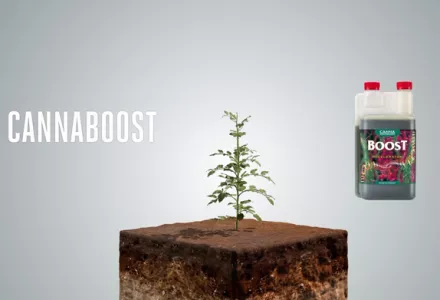Booster quite literally means a product or substance used to initiate or accelerate a process, to deliver an injection of energy. In plant cultivation boosters are products whose ingredients influence the vital processes of the plant, with positive outcomes for the grower. These substances are often referred to as 'stimulators' and they continuously encourage processes going on in the plant.
Light and nutrition are two obvious means of influencing biological processes in the plant; many plants are sensitive to day length for example and will start to form flowers in response to a change in the hours of light they receive. You will also be familiar with the effects of nutrition on the development of plants. Light and nutrients are not considered as boosters however, otherwise we would be calling everything a plant needs for healthy growth a 'booster'.

Boosters are therefore defined as products whose ingredients are not essential for the plant, but which nevertheless have substantial impacts on its processes. However, if the plant's essential needs for light, water and nutrition are not met, administering a booster cannot be expected to deliver a better plant compared to a situation where those basic requirements were met.
Boosters may seem to have almost magical properties, but that is quite wrong, as the effects of their constituents are actually well understood. Unfortunately the secrecy that often surrounds the nature of the active ingredients sometimes causes a temptation to mislead purchasers. As a result this leads to a believer versus non-believer situation.
The definition of a booster
Yet using the definition of a ‘booster’ actually makes it easy to recognise a genuine one: “A booster stimulates one or more linked processes in the plant, and the active ingredient(s) are not essential requirements for the survival of the plant.”
To be clear, products used in plant cultivation incorrectly identified as boosters may be excellent products, but they just aren’t boosters. It's thought that around 85% of the products promoted as a 'booster' may fall into that category.
When purchasing a booster one should consider the following:
The product ingredients:
- Are these macro or trace elements, whether or not in special forms such as chelates or EDTA? Are terms like 'minerals' or 'nutrients' used? If so, you can be sure that you are dealing here with a fertiliser, possibly with further additives.
- Does the product contain numerous unfamiliar substances? A booster isn’t a magic potion, with as many weird ingredients as possible! Check whether the claims made for the product match up with the properties of a booster.
Product claims:
- Is the product described as affecting factors other than processes in the plant? There might for example be claims about effects on organisms in the soil, or effects on the growing medium. However exceptional such a product may be, it isn't a booster.
- Are claims made about effects on several unconnected processes in the plant, promoting growth in both the vegetative and flowering phases? If so it may be wise to have doubts about the effectiveness of such a product.
CANNABOOST

CANNABOOST Accelerator is a booster specifically developed to optimise the formation of flowers. The active ingredients in CANNABOOST which stimulate flower development are so-called ‘oligosaccharides’ of different types.
Oligosaccharides occur widely in nature and can be described in biochemical terms as short chains of molecules which may or may not consist of different types of sugar. Oligosaccharides are present in CANNABOOST in precise proportions, which allow them to reinforce or supplement one another's effects.
The concentrations of the different oligosaccharides and the applied concentration are also important in achieving the desired results. It is the ratios between the different oligosaccharides and their concentrations in CANNABOOST when diluted for application, that determine the product's unique effects on flower formation.
CANNABOOST leads to improvement
Recent research has shown that, among other effects, the use of CANNABOOST alters the composition of the substances found in the leaf. The leaves exhibit a more productive profile than those of plants grown without CANNABOOST, meaning the crop was in the generative phase both earlier and more distinct. In Pelargonium graveolens this change resulted in a higher dry matter content in the flowers, while cut flowers of Chrysanthemum rubellum stand longer in the vase when the plants have received CANNABOOST during cultivation.
These studies and others show that the use of the product CANNABOOST leads to both qualitative and quantitative improvement in flower-related end products.





